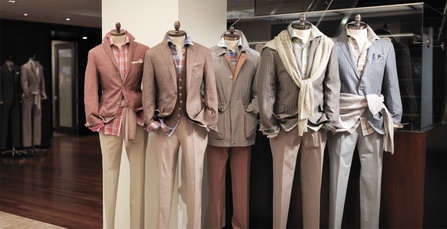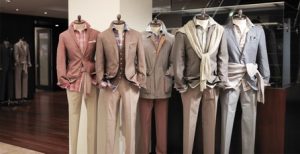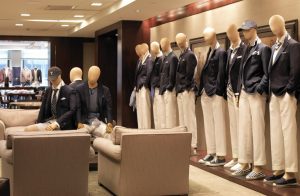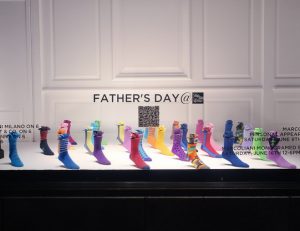The world market for menswear is expected to exceed $402 billion in 2014, according to research firm MarketLine Intl. Ltd. (London), with clothing and footwear as the leading segments. Whether you thank Don Draper, Ralph Lauren or millennial males, the truth is more men across all ages and demographics are having fun with their wardrobes. “There’s a whole new generation of guys who like to get dressed up,” says Tom Beebe, vp, creative services, clothing company HMX Group (New York).
But it’s not the usual navy suit or khakis and white oxford shirt they’re going for. Rather, men are accessorizing with pocket squares and colored socks and mixing polka-dot ties with brightly colored checkered shirts. “They’re wearing color like never before,” Beebe says.
As fashion has opened itself up to men, several retailers are following suit with expanded product offerings and renovated spaces.
Earlier this year, Joseph Abboud, president and ceo of HMX Group, signed up with Russell Simmons to design and re-release the hip-hop mogul’s Argyleculture line. “This is like preppy on steroids,” Abboud told Women’s Wear Daily about the sportswear collection, which is being sold in department stores such as Macy’s. “The colors are bright and the styling is aggressive … this pushes the envelope.”
In August, Christian Louboutin opened its first men’s store in New York’s Meatpacking District. Macy’s Herald Square renovation includes the largest men’s store in the country, to be completed by 2015. And Bergdorf Goodman recently unveiled a major renovation to its men’s store, including a revamp of its contemporary designer space and the addition of a shoe library on the main floor. Across the pond, Selfridges has expanded its men’s offering with a new designer area, fresh-off-the-runway styles and a 10,000-square-foot men’s shoe hall, double the size of the previous one, WWD reports.
Bring It to Life
Going from the runway to the sales floor, the trend is influencing the way retailers are presenting and selling their products. No longer the stuffy, beige environs of years’ past, today’s menswear departments are coming alive with fun, bold visual merchandising presentations and colorful store accents. What may have started with J.Crew’s Liquor Store, which reincarnated a bar in Tribeca into a boutique showcase for hip menswear, has evolved into such current statements as Bergdorf’s new men’s shoe area that is inspired by the Villa Necchi in Milan and features an ocher and olive palette. Louboutin’s new men’s store pairs diamond-panel leather walls with exposed piping and utility conduits in the ceiling.
Advertisement
Saks Fifth Avenue recently added bold red carpets to the sixth-floor classics department of its New York flagship. “It’s obnoxious in a cool way,” says Harry Cunningham, Saks’ senior vp, store planning and visual merchandising. “It gives it some life and keeps it fun.”
The trend is also giving retailers license to enliven their store windows. Tasked with “making ties and shirts more interesting,” Saks’ Cunningham says for Father’s Day, the luxury department store retailer presented more than 50 sock forms in a window, each wearing a different style. In another, 150 pocket squares were seen “poofing out” from a white board for a visually inspired display. “It’s bringing interest back,” he says.
Push for Cool
Still, there’s room for improvement, says Lee Peterson, executive vp, creative services, WD Partners (Dublin, Ohio). In the firm’s research paper, “The Continuum of Cool: How to Navigate the Boomer-Millennial Divide,” Peterson says both millennial and boomer men rated attributes like price/value, store environment and online and brand qualities lower than women. “They’re not seeing anything they relate to,” he says, “because we’re not addressing their needs.”
That should give retailers an incentive to help men understand the importance of store design, Peterson says, pointing to Ralph Lauren RRL stores in New York and California as good examples of places that cater to this new male shopper. Here, the brand utilizes the existing character of the space, such as exposed brick walls and time-worn flooring, enhancing it with found items and strong visual merchandising, for a masculine and comfortable setting.
He adds that men also respond to simple messaging and brutal honesty (even delivered in a funny way), pointing to Ford Truck’s powerful graphics and its advertising campaign featuring spokesperson Denis Leary. In-store, he says, they also respond to cross-selling. “If they see direction, they’ll buy,” says Peterson. “It’s the idea of ‘I See Me.’”
One way to deliver that is through displays that cross-merchandise and showcase entire outfits, especially targeting older generations. “Younger men and millennials are more comfortable putting looks together,” says Marcie Merriman, founder of retail strategy and design firm PrimalGrowth (Columbus, Ohio). “But those in their 30s and older have never had to because they are used to wearing business casual. The rules that these guys grew up with are now obsolete.”
Advertisement
But they’re also looking for that experience to be fast and easy. “They’ll spend less time in a store, but they’ll spend more money,” says Merriman. “They care less about price if they can get what they want easily and trust that it’s right for them.”
HMX’s Beebe says one way to convey a sense of confidence is through your branding and visual presentations. “You need to give them the confidence that this is what they want,” he says.
So how do you do that? Since men are traditionally “category shoppers,” going into a store only for a new pair of shoes or a belt as opposed to grazing the store for anything that catches their eye, they rely heavily on a retailer or brand to edit down the merchandise selection. So instead of showing all the tie choices, narrow it down to the best choices and hippest colors.
“We need to show them the icing,” Beebe says.


 Photo Gallery2 days ago
Photo Gallery2 days ago
 Headlines1 week ago
Headlines1 week ago
 Headlines2 weeks ago
Headlines2 weeks ago
 Sector Spotlight2 weeks ago
Sector Spotlight2 weeks ago
 Headlines1 week ago
Headlines1 week ago
 Headlines3 days ago
Headlines3 days ago
 Headlines1 week ago
Headlines1 week ago
 Designer Dozen7 days ago
Designer Dozen7 days ago


















